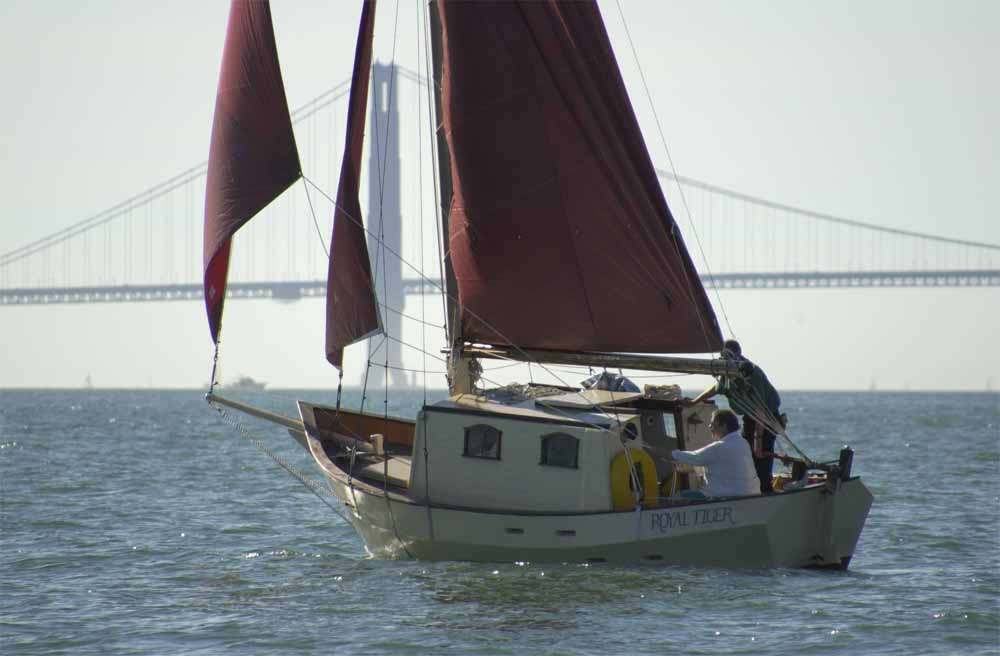
The Royal Tiger
Let's see how many of the particulars I can remember. I have to say that she is an old lady -about 40 years, but she has been in storage most of the time. She still has a lot of fun in her. She needs an owner who is not disinclined to do a little maintenance -proactive and otherwise. Such is the nature of wood boats. I promise you however -that she will get second -and third- looks. But we are talking Dolly Parton here, not Angelina Jolie -or Audry Hepburn- for the more mature and discerning sailor.
Her hull is 22 feet long (Plus 4 ft of bowsprit and the boom sticks out the back far enough -and seems to me it's about 3 feet- that slippage runs $193 / month.
LWL is 19 feet or so.
Beam is 9 1/2 feet -and yep, she is built far more for comfort more then speed -and for that matter, whatever speed she will develop will be down-wind.
Displaces something under 6000 pounds, but I have never weighed her. What I did do, however, was melt about 900 pounds of lead. Most bolted to the keel -a little scattered strategically about he bilges.

I didn't take this picture -didn't even know about it till the after magazine came out -but I'm pretty sure that's the Golden Gate Bridge in the background. Those are Dacron tanbark sails made in Hong-Kong - they've spent almost their entire lives in their bags in the garage.
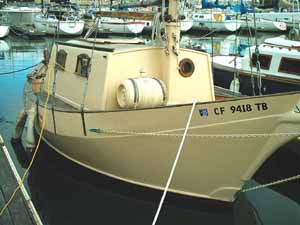
This is the Royal Tiger in her birth in Alameda. (On pier 7 -the best party-pier in the Alameda Marina.) The bumpers come with -but they are pretty old and not really necessary anyway in a birth with piers on both sides.
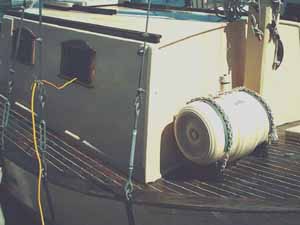
The foredeck. The fuel tank is indeed an aluminum beer keg. The yellow wire goes to a fancy charger that keeps the batteries happy and topped up. Otherwise, not much to say about this view. The standing rigging is galvanized turnbuckles and galvanized aircraft-cable of a very generous size. Consists of fore and aft lowers, uppers over fir spreaders, and a fore-shroud off the bow and another off the end of the bowsprit. Chain plates are bronze on one side and stainless on the other -don't ask why. Rigging to the bowsprit is galvanized chain with bronze hardware -also of a generous size.
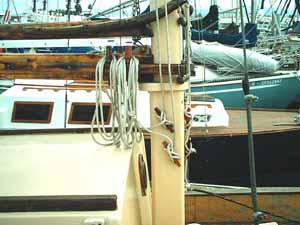
Now this may take some 'splaning. It's a gaff rig so it's has all manner of halyards and rigging. On the starboard side of the mast are throat and peak halyards for the main-sail. The front of the mast carries halyards for the stay-sail and jib. The port side has foot, tack, and clew for the top sail. It all hangs off cute little belaying pins. Both the boom and gaff are spruce and in great shape, -nicely aged, but in great shape. The gaff jaws (fir) & gaff jaws (curve-laminated plywood) have parrel trucks -little wooden balls to hold it to the painted aluminum mast. The main laces to the mast -and this is -we find- is one of those areas where old-ways are the best ways -the sail goes up and down easily and has never jammed. (Getting the gaff up is another matter however -in this case it's an example of the days when ships were wood and sailors were iron.)
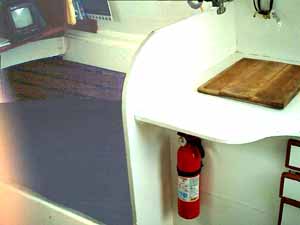
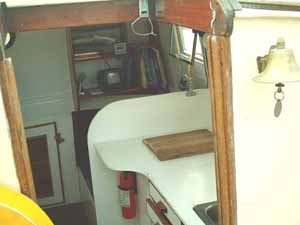
I'm 6' 4" in a vertical direction and the only place I can stand up is standing at galley with my head out the hatch. But if you measures in at 5" 8" or so, I think you could stand upright throughout. The galley has a little sink with a hand pump to a 5 gallon jerry can under. The cutting board on the left is the lid to a deep and well insulated icebox. You can just see a few of the 5 drawers between the ice-box and "under the sink. BTW. The fuel filter is mounted to the bulkhead under the sink and the "control panel" is at eye-level to the right of the sink.
There is the charger -and I spent more then I wanted to on it and am damn glad I did. You can see the charger on the aft bulk-head below. There are two reasonably new deep discharge marine batteries -and it turns out that this is why you buy the good charger -the batteries like it. A few words on the wiring might be appropriate. Frankly, it needs work. The important bits work, but rarely does everything work at once. It needs authentic marine wire and connectors. Lights consist of navigation-lights, "under-power' nav lights (a forward looking white light mounted up the mast, spreader lights -one side looks to the fore-deck and the other looks aft, cabin lights (I use shore power for reading and TV etc.) and a separate circuit to the stern and front of the cabin with plugs for a portable spot-light. There are ON/ OFF / Manual selector switches to port and starboard bilge pumps, but I have the pumps wired up directly to individual float switches and the two separate batteries. The batteries have a big old vapor-proof selector switch, but the bilge pumps and charger are wired to work even when this switch is set to OFF.
There are two fire extinguishers -one in the lazarette, and one under the galley counter (you can see it above). The lazarette also has 5 or 6 wearable life preservers and there is a horseshoe throw-able one mounted to the bulkhead in the cockpit -on the other side of the charger. There is also a spot light with a rechargeable battery in the lazarette.
There is gobs of storage under the births. If you doubt this, have a look at the boat from the outside. Can you say "hard-chine" boys and girls? There is also water sloshing around in these bilges. I have installed battens to keep my tool boxes etc out of the water, but I'd only store things like tools and canned food etc. -in plastic containers if I were you. Despite the wet in the bilges, it scarcely leaks. The pumps run for 20 or 30 seconds every four or five hours.
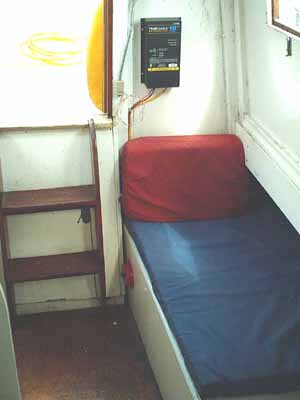
From forward -looking aft- at the port single-birth, companion-way ladder, and the fancy battery charger. Actually, I usually take the cushions off and use the birth as a work bench, storage place, and place to toss things I will need in a minute.
The ladder comes out and the plywood panel come off to allow access to the front of the engine. The box -visible from the stern, also come off to allow many full filled hours working on the engine. But the engine actually works pretty well. It's an old OLD German diesel --a Kermit Ferryman- one lung, glow plug (that I never need to use to get the beast awake and running), 12 volt starter, all manner of senders and gauges that I distrust, but they are there. Cooling is fresh water -a 1/2" copper pipe goes out the bottom, runs to the bow on one side of the keel, through the keel, back down the other side and back inboard to cool the beast. There is a raw water intake too that pumps water into the exhaust manifold just upstream of a big rubber steam hose. It all works pretty well. When it's running, there is no doubt there is a engine running somewhere close at hand, but you can talk in over it. Both the cooling pump and exhaust pumps are good English bronze with new neoprene impellers. There is an alternator and voltage regulator -but these are the parts of I don't trust.